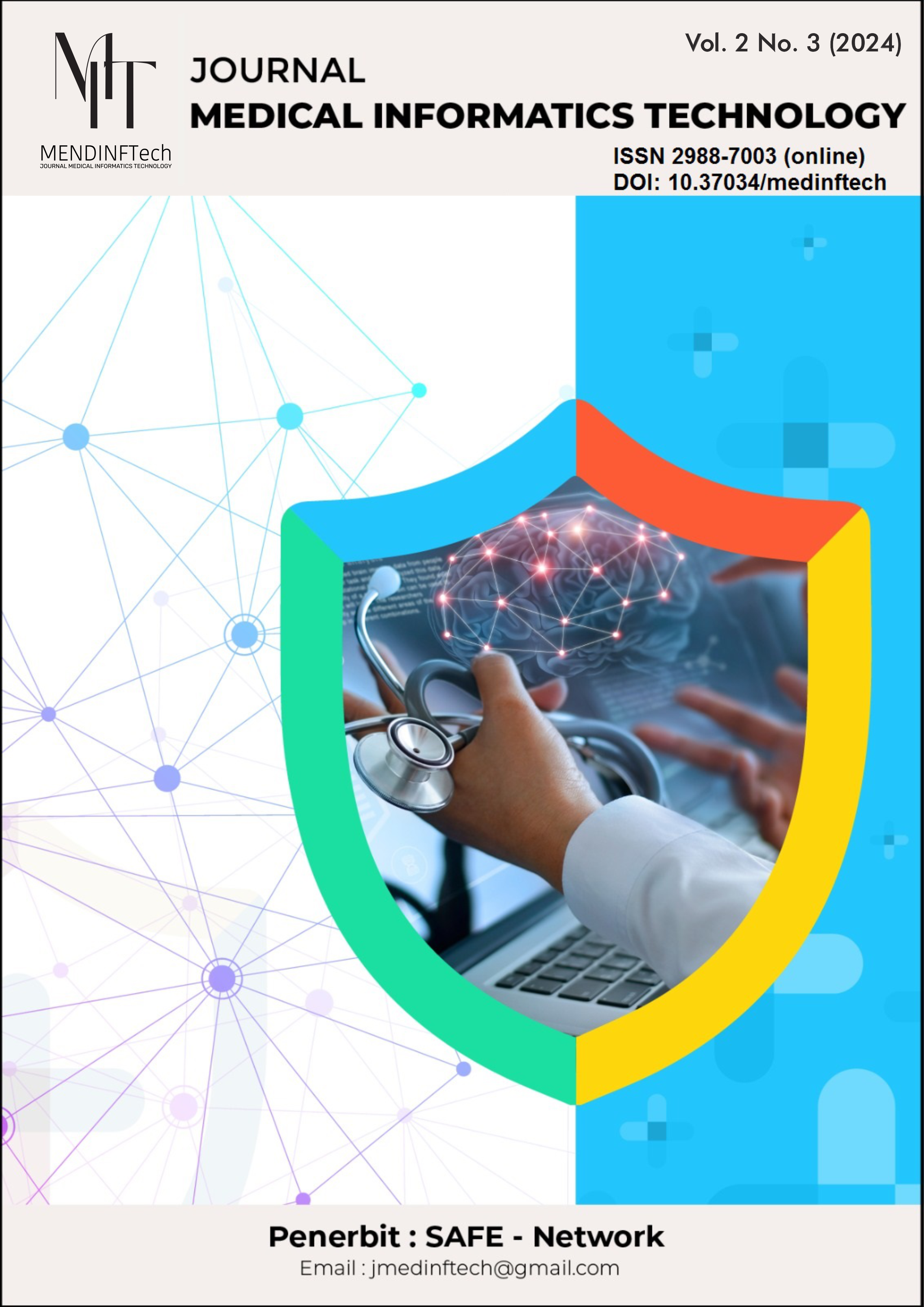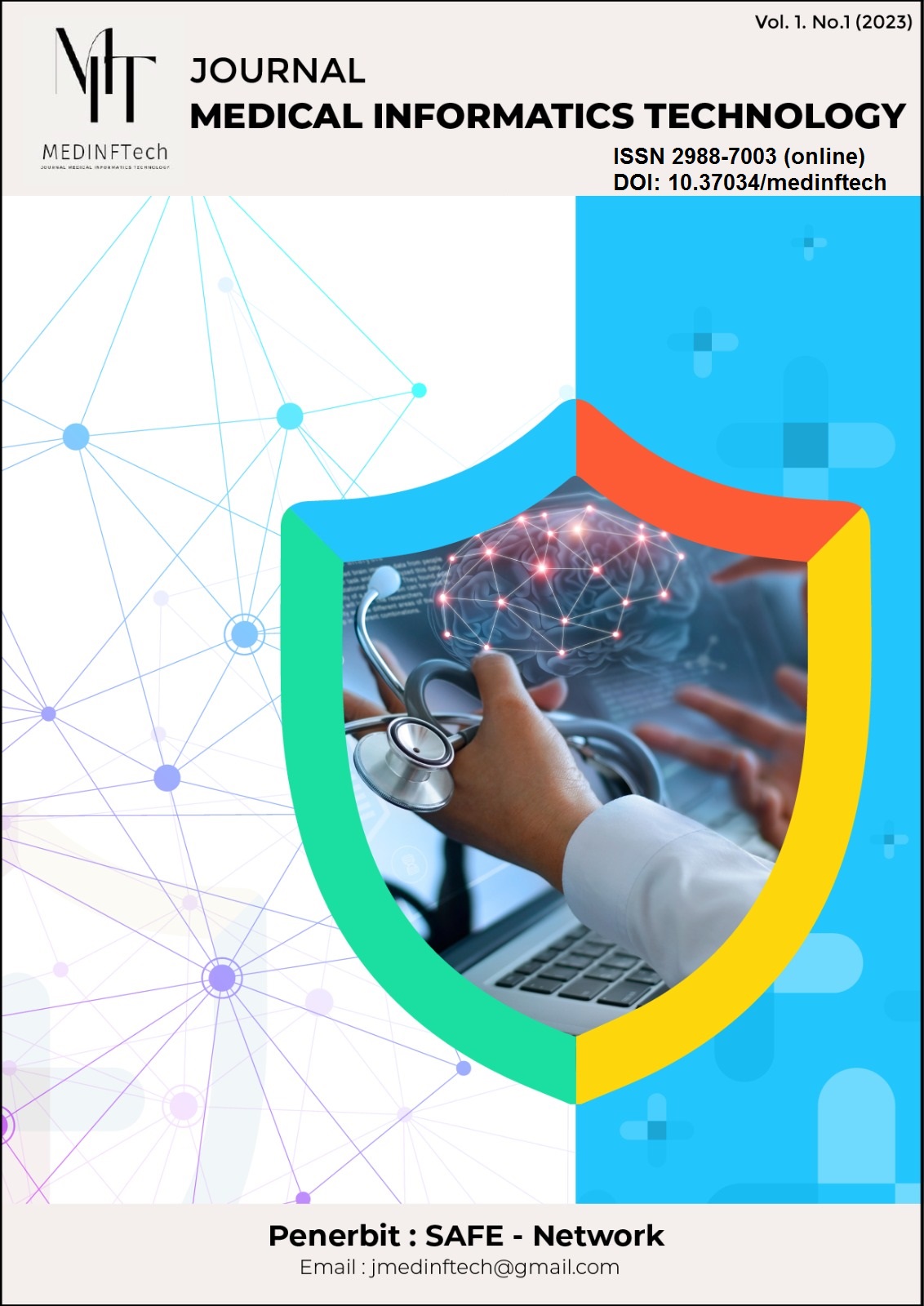Analyzing User Experience and User Satisfaction: Evaluating User Acceptance of the Halo Hermina App
DOI:
https://doi.org/10.37034/medinftech.v2i3.45Keywords:
Correlation Analysis, Halo Hermina Mobile Health Application, User Acceptance, User Experience, User SatisfactionAbstract
This research investigates the factors influencing user acceptance of the Halo Hermina mobile health application through an analysis of user experience and satisfaction. The study utilized a survey method to gather feedback from Halo Hermina users, assessing the questionnaire's validity and reliability. The results indicate strong validity across most items, with correlation values between 0.779 and 0.828 for performance expectancy and over 0.77 for effort expectancy. The reliability analysis shows high internal consistency, with Cronbach's Alpha values exceeding 0.976. User satisfaction scored the highest mean (4.027), indicating a consistent high level of satisfaction among users. The correlation analysis reveals significant relationships between performance expectancy, effort expectancy, facilitating condition, and behavioral intention, with the strongest correlation found between performance expectancy and effort expectancy (0.8796). Overall, the study emphasizes the crucial role of enhancing user experience and satisfaction to boost the adoption of mobile health applications like Halo Hermina, providing valuable insights for developers and stakeholders to enhance application features and service quality to meet user expectations effectively.
Downloads
References
C. Wang and H. Qi, “Influencing Factors of Acceptance and Use Behavior of Mobile Health Application Users: Systematic Review,” Healthcare, vol. 9, no. 3, p. 357, Mar. 2021, doi: 10.3390/healthcare9030357.
X. Zhang, X. Han, Y. Dang, F. Meng, X. Guo, and J. Lin, “User acceptance of mobile health services from users’ perspectives: The role of self-efficacy and response-efficacy in technology acceptance,” Inform. Health Soc. Care, vol. 42, no. 2, pp. 194–206, Apr. 2017, doi: 10.1080/17538157.2016.1200053.
T. Shemesh and S. Barnoy, “Assessment of the Intention to Use Mobile Health Applications Using a Technology Acceptance Model in an Israeli Adult Population,” Telemed. E-Health, vol. 26, no. 9, pp. 1141–1149, Sep. 2020, doi: 10.1089/tmj.2019.0144.
R. Dimitrova, and P. H. Ketikidis, “Customers’ Technology Acceptance of Mobile Applications for Personalized Healthcare,” in Proceedings of the 18th international symposium on health information management research, Linnaeus University Press, May 2022. doi: 10.15626/ishimr.2020.02.
S. Fan, R. C. Jain, and M. S. Kankanhalli, “A Comprehensive Picture of Factors Affecting User Willingness to Use Mobile Health Applications,” ACM Trans. Comput. Healthc., vol. 5, no. 1, pp. 1–31, Jan. 2024, doi: 10.1145/3626962.
Z. Deng, “Understanding public users’ adoption of mobile health service,” Int. J. Mob. Commun., vol. 11, no. 4, p. 351, 2013, doi: 10.1504/IJMC.2013.055748.
M. Sediono and S. Kusumadewi, “Analisis User Acceptance Pada Aplikasi Layanan Kesehatan Online di Jawa Tengah dan Daerah Istimewa Yogyakarta,” JATISI J. Tek. Inform. Dan Sist. Inf., vol. 9, no. 1, pp. 203–218, Mar. 2022, doi: 10.35957/jatisi.v9i1.1463.
S. A. Iverson, K. B. Howard, and B. K. Penney, “Impact of internet use on health-related behaviors and the patient-physician relationship: a survey-based study and review,” J. Am. Osteopath. Assoc., vol. 108, no. 12, pp. 699–711, Dec. 2008.
C. F. Van Uden-Kraan, C. H. C. Drossaert, E. Taal, B. R. Shaw, E. R. Seydel, and M. A. F. J. Van De Laar, “Empowering Processes and Outcomes of Participation in Online Support Groups for Patients With Breast Cancer, Arthritis, or Fibromyalgia,” Qual. Health Res., vol. 18, no. 3, pp. 405–417, Mar. 2008, doi: 10.1177/1049732307313429.
Y. Gabriel, “The Voice of Experience and the Voice of the Expert ‐ Can they Speak to each Other?,” in Narrative Research in Health and Illness, 1st ed., B. Hurwitz, T. Greenhalgh, and V. Skultans, Eds., Wiley, 2004, pp. 168–186. doi: 10.1002/9780470755167.ch11.
J. D. Piette, J. A. Blaya, I. Lange, and J. B. B. Sanchis, “Experiences in mHealth for chronic disease management in 4 countries,” in Proceedings of the 4th International Symposium on Applied Sciences in Biomedical and Communication Technologies, Barcelona Spain: ACM, Oct. 2011, pp. 1–5. doi: 10.1145/2093698.2093868.
D. H. Daudelin, M. Kwong, J. R. Beshansky, and H. P. Selker, “Using Specialized Information Technology to Reduce Errors in Emergency Cardiac Care,” in Advances in Patient Safety: From Research to Implementation (Volume 3: Implementation Issues), K. Henriksen, J. B. Battles, E. S. Marks, and D. I. Lewin, Eds., Rockville (MD): Agency for Healthcare Research and Quality (US), 2005. Accessed: Jul. 02, 2024. [Online]. Available: http://www.ncbi.nlm.nih.gov/books/NBK20561/
E. Wilson, "Exploring the Role of Specialized Health Apps: Lessons from the Halo Hermina App," Health Informatics Review, vol. 20, no. 3, pp. 145-159, Jul. 2024.
F. Martinez, "Integrating Health Services into Mobile Apps: A Study of User Experiences," Journal of Medical Systems, vol. 39, no. 5, pp. 180-189, May 2022.
L. Zhou, C. C. B. Hsu, and Y. Wu, "The Role of Usability in Mobile Health Apps: A Systematic Review," Health Information Science and Systems, vol. 6, no. 1, pp. 1-13, Dec. 2018.
X. Huang, L. J. Fang, and M. B. Li, "User Experience and Satisfaction in Mobile Health Applications: A Review," Journal of Biomedical Informatics, vol. 92, pp. 103-114, Aug. 2019.
E. Sezgin, S. Özkan-Yildirim, and S. Yildirim, “Investigation of physicians’ awareness and use of mHealth apps: A mixed method study,” Health Policy Technol., vol. 6, no. 3, pp. 251–267, Sep. 2017, doi: 10.1016/j.hlpt.2017.07.007.
R. R. Pai and S. Alathur, “Assessing mobile health applications with twitter analytics,” Int. J. Med. Inf., vol. 113, pp. 72–84, May 2018, doi: 10.1016/j.ijmedinf.2018.02.016.
M. L. East, B. Havard, and N. B. Hastings, “Mental Health Mobile Apps’ Instruction: Technology Adoption Theories Applied in a Mixed Methods Study of Counseling Faculty,” J. Technol. Hum. Serv., vol. 34, no. 4, pp. 301–325, Oct. 2016, doi: 10.1080/15228835.2016.1233842.
Z. Namesztovszki, L. Major, C. Kovacs, D. Karuovic, and G. Molnar, “Research of the usage of health-behavior improving mobile applications,” in 2019 10th IEEE International Conference on Cognitive Infocommunications (CogInfoCom), Naples, Italy: IEEE, Oct. 2019, pp. 619–624. doi: 10.1109/CogInfoCom47531.2019.9089953.
G. M. Coorey, L. Neubeck, J. Mulley, and J. Redfern, “Effectiveness, acceptability and usefulness of mobile applications for cardiovascular disease self-management: Systematic review with meta-synthesis of quantitative and qualitative data,” Eur. J. Prev. Cardiol., vol. 25, no. 5, pp. 505–521, Mar. 2018, doi: 10.1177/2047487317750913.
A. Navarro et al., “Developing mobile health applications for neglected tropical disease research,” PLoS Negl. Trop. Dis., vol. 12, no. 11, p. e0006791, Nov. 2018, doi: 10.1371/journal.pntd.0006791.
R. Debon, J. D. Coleone, E. A. Bellei, and A. C. B. De Marchi, “Mobile health applications for chronic diseases: A systematic review of features for lifestyle improvement,” Diabetes Metab. Syndr. Clin. Res. Rev., vol. 13, no. 4, pp. 2507–2512, Jul. 2019, doi: 10.1016/j.dsx.2019.07.016.
S. J. Miah, J. Gammack, and N. Hasan, “Extending the framework for mobile health information systems Research: A content analysis,” Inf. Syst., vol. 69, pp. 1–24, Sep. 2017, doi: 10.1016/j.is.2017.04.001.
R. R. Pai and S. Alathur, “Bibliometric Analysis and Methodological Review of Mobile Health Services and Applications in India,” Int. J. Med. Inf., vol. 145, p. 104330, Jan. 2021, doi: 10.1016/j.ijmedinf.2020.104330.
W. Peng, S. Kanthawala, S. Yuan, and S. A. Hussain, “A qualitative study of user perceptions of mobile health apps,” BMC Public Health, vol. 16, no. 1, p. 1158, Dec. 2016, doi: 10.1186/s12889-016-3808-0.
V. Venkatesh, J. Y. L. Morris, G. B. Davis, and F. D. Davis, "User Acceptance of Information Technology: Toward a Unified View," MIS Quarterly, vol. 27, no. 3, pp. 425-478, Sep. 2003.
T. Lee, C. Choi, and S. Kim, "The Influence of Perceived Value and Trust on User Satisfaction in Health Technology Acceptance," Health Services Research, vol. 55, no. 4, pp. 1054-1065, Apr. 2020.
R. Cunningham, M. L. Williams, and H. C. Anderson, "Impact of User Engagement and App Functionality on Satisfaction: Evidence from Mobile Health Apps," Journal of Medical Internet Research, vol. 23, no. 2, pp. e14567, Feb. 2021.
A. Patel, K. A. Sharma, and P. J. Choudhury, "Effects of User Interface Design and Personalization on User Satisfaction in Health Apps," Journal of Health Informatics, vol. 29, no. 1, pp. 58-73, Jan. 2022.









